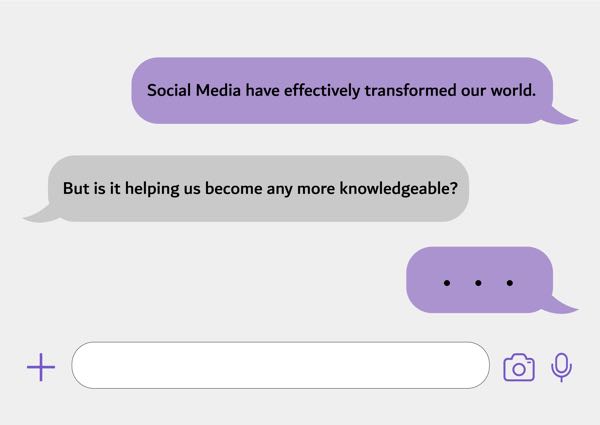Social Media has effectively transformed our world. News circulated on Twitter, Facebook, or Instagram can cross borders in split seconds. But is it helping us become any more knowledgeable?

“In general, the greater the understanding, the greater the delusion” – George Orwell, 1984.
Today, we tend to think of ourselves as well-informed individuals because the internet and social media supposedly enable us to develop comprehensive opinions about various global news or events. We no longer wait for the next morning’s newspaper to get published or make sure that we catch the 8 pm news recap on local channels. Right on our fingertips lies a seemingly free market of ideologies, views, and perspectives. But what if social media, instead of connecting us to the world, is keeping us all locked inside invisible bubbles?
On the 18th of January, a Twitter account posted a minute-long video of an American teenager, wearing a Make America Great Again hat, in what seemed to be an intense confrontation with a Native American elder [1].
The original video was viewed at least 2.5 million times on Twitter before the account that first posted it deactivated. It was then reposted by hundreds of thousands of people on Facebook, Instagram and found its way to major network channels.
Intrigued by the outrage it generated, journalists in the US investigated the account that initially posted the video, exposing that it was impersonating an American teacher and that it was part of a larger online political network [2]. Some began to question the legitimacy of the one-sided narrative which blamed the teenager, especially after more videos of the confrontation surfaced. In a video capturing the moments leading up to the viral incident, it was clear that tension was already building up by a group of anti-Trump protesters who were shouting slurs at the Trump-supporting teenagers. Mr. Phillips, the Native American elder, then stepped in and walked towards the teenagers to “defuse the tension” [3].
If anything, this is a classic example of how inadequate our understanding of news can be. There is no denying that social media has already replaced traditional news outlets and become the main source of information. The protests and clash in the example mentioned above were better documented by regular people that were in the scene rather than TV correspondents. Likewise, the material circulating in news channels about Hurricane Maria, the protests of the yellow vests in France, or the Manchester terror attack were all extracted from videos captured by the smartphones of regular people.
The overall consequences of this trend are undeniably alarming. Whereas traditional media do not want to risk their reputation by posting a rumored video without verifications, anonymous accounts in social media have little to lose. Moved by anger, emotions and sometimes pride, sheer rumors can get a big reach in a matter of few seconds. Further, tracking the sources of news or social media content can become a complicated challenge – as it is difficult to understand the possible motives behind a posted information or video.
Some might argue that we can always turn to traditional media for verified and legitimate news. Nonetheless, mainstream journalism has negatively affected traditional news covering dynamics. In the fierce online competition for likes and retweets, major and trustworthy news channels feel inclined to take the lead in posting news. Consequently, news posted online do not go through the traditional verification phases. Recently, many high-profile mistakes were made in news reports and coverages that costed some journalists their jobs [4].
Even worse, social media algorithms, intentionally or unintentionally, created a system that is designed to keep us all in own bubbles. Based on what we view and who we follow, we are more likely to come across posts and videos that are aligned with our stand-points and beliefs. All of which makes it almost impossible to view content that challenges our minds.
For now, it seems that all we can do is to be mindful of the flaws and limitations in the new-age of social media journalism. In the unlimited pool of news, we can easily fall to the trap that we already know all sides of a story. Thus, as information seekers, it is essential that we keep a critical eye and mind when browsing through the news. We must understand that the truth has many faces, some of which we will never get to see.
References
[1] https://www.youtube.com/watch?v=4_rjRj3_axQ
[2] https://www.nytimes.com/2019/01/23/technology/
covington-video-protester-congress.html?smid=tw-nytimes&smtyp=cur
[3] https://www.nytimes.com/2019/01/21/us/viral-video-covington-kentucky.html?module=inline
[4] https://www.poynter.org/fact-checking/2017/not-fake-news-just-plain-wrong-top-media-corrections-of-2017/


